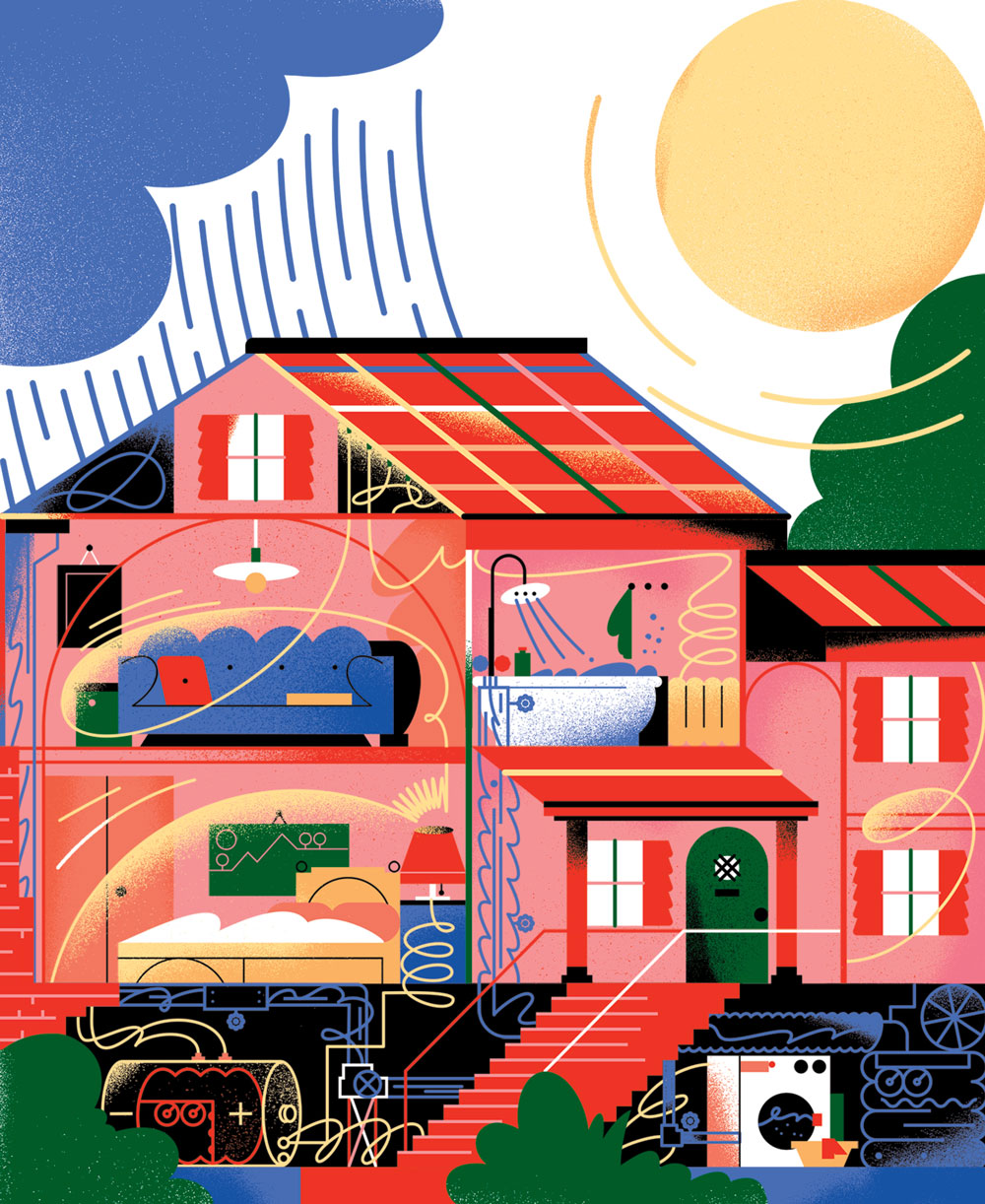
Illustration by Bratislav Milenković
Roswell architect Simone du Boise grew up along the South Carolina coast, where her father was one of the original developers of Hilton Head Island. But du Boise—who constructed the first platinum-level, LEED-certified house in Georgia—credits her Gullah nanny with sparking her passion for green building.
Gullahs are direct descendants of freed African slaves who live on Low Country barrier islands, where they have uniquely preserved much of their ancestral language and customs. “The Gullah never take more than what they’ll use,” says du Boise. “They’re very respectful of the land. As a child, I had my own jon boat. On Sundays I’d go out by myself, navigating tides and a labyrinth of sawgrass. As the morning fog lifted and I approached the island, MeeMaw and her family would be on the dock waiting for me—all dressed in starched white for church. I would think to myself, This is what angels look like.”
A self-proclaimed “Geechee girl,” the young du Boise rejected the wasteful resort construction techniques she witnessed and was determined to find a better way to build. The world doesn’t need more developers, she reasoned, but it does need environmental stewards. In architecture school at Georgia Tech, fellow classmates teased her about being “anti-architect.”
Nonetheless, the contrarian du Boise amassed an impressive resume as an architect. As a Fulbright scholar, she studied ancient temples in Southeast Asia—research cut short by the Gulf War. She managed major commercial projects, eventually becoming lead architect for General Motors.
In the mid-1990s she met a kindred spirit, Roswell-based interior designer and artist Denise Donahue. Like du Boise, Donahue finds creative inspiration from childhood figures, including her Polish-born carpenter grandfather, who worked on the Chrysler building, and her father, who helped invent the bar code. Donahue’s right-brain ingenuity complemented du Boise’s left-brain mechanics. “She’s the ‘what if,’ and I’m the ‘how to,’” says du Boise.
The couple committed both to each other and to exploring environmentally responsible construction. They eventually founded Cadmus Design Build to adapt proven commercial methods to residential settings. Together, they developed a model called the EcoCraft Hybrid Home, which aims for “Net Zero Energy”—a building that consumes no more energy than it produces. In a Cadmus prototype, solar panels heat 80 percent of the household’s hot water and fuel at least 50 percent of required electricity (new technology may soon capture even more energy). Custom gutters and downspouts harvest 90 percent of rainfall, storing it in giant underground cisterns for irrigation, though drought-resistant landscaping minimizes the need for watering. Indoor materials and finishes emit virtually no harmful chemicals.
Du Boise and Donahue have refined their model in an enclave called Weatherford Place, built along Crossville Creek within walking distance of Roswell’s popular Canton Street district. The eight planned homes range from 4,900 to 5,500 square feet, with the three remaining houses on the market starting in the high $900s—comparable to other similarly sized new builds nearby. From the 2007 launch, it was apparent this was no ordinary subdivision. Construction started with a “ground blessing” rather than a “groundbreaking,” and almost all waste is recycled, down to sawdust used as ground cover. (During the recession, the project slowed and Cadmus switched its focus to commercial work. However, the hiatus allowed them to gather data on the prototype, which earned the best home energy rating score on record, with a first-year electric bill of $0.)
Despite the cutting-edge technology, Weatherford homes fit seamlessly into their historic district. Rather than clunky solar panels, a flexible film—the first of its kind in the Southeast—is integrated into what appears to be a traditional metal roof. Deep overhangs, steeply pitched gables, and cantilevered projections add cottage flavor and aid energy efficiency.
The interior has upscale features like vaulted and cathedral ceilings, a gourmet kitchen, vessel sinks, a wine cellar, and biofuel fireplaces. Deep windowsills and solar tubes (think skylights with reflective tubes) amplify natural light. Hickory floors were planed from trees grown within 500 miles.
There was also a conscious effort to provide for aging in place. Homes feature details like wide, pocket doors that can accommodate wheelchairs, lever door handles, and showers with bench seats. Surprises like a three-story dumbwaiter, multistory elevator options, and a Murphy bed hidden in the first-floor study help occupants cope with stairs.
Next up is Canton Mews, an 11-unit condo complex, also within walking distance of Canton Street. The one– to three–bedroom units will be built to the same environmental standards as Weatherford Place, with pricing projected to start in the high $200s. Cadmus hopes to begin construction early this year.
“We have some buyers who purchased because of the location and design who were not even aware of the homes’ environmental, sustainable attributes,” says du Boise. “Others were looking for homes with alternative energy [sources] but did not like the look of typical crystalline panels. And, amazingly enough, sometimes the children are the ones who are familiar with terms like xeriscaping, integrated solar photovoltaics, carbon footprint, volatile organic compounds, LEED, and SRECs (solar renewable energy credits). It has definitely been an educational process.”













